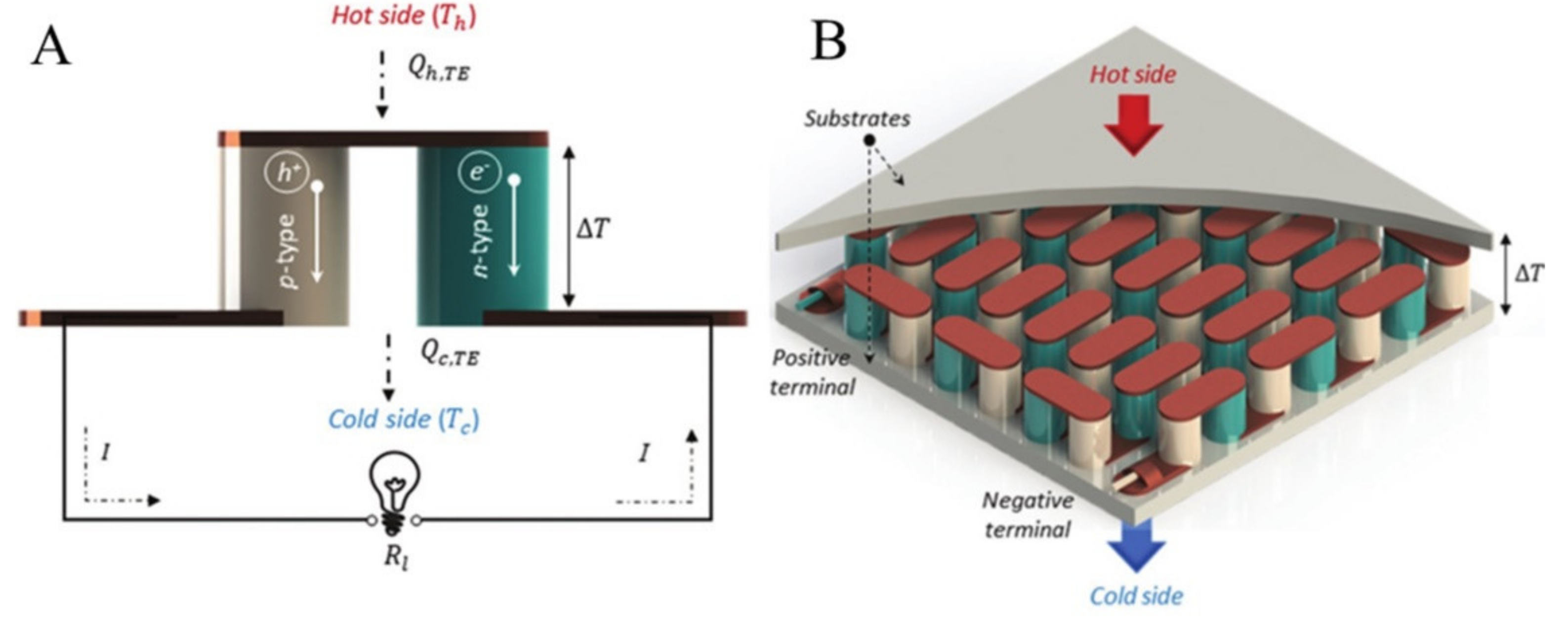Review on Wearable Thermoelectric Generators: From Devices to Applications
Abstract
:1. Introduction
2. Thermoelectric Generators
2.1. Basic Concept of Thermoelectric Generators
2.2. Heat Transfer Model of Human Body as Heat Source
2.3. Different Types of Wearable TEGs Based on Inorganic Bulk Materials
2.3.1. Rigid Wearable Thermoelectric Generators (r-WTEGs)
2.3.2. Flexible Thermoelectric Generators (FTEG)
Non-Stretchable Flexible Thermoelectric Generators (ns-FTEGs)
Stretchable Flexible Thermoelectric Generators (s-FTEGs)
3. Optimization of Wearable Thermoelectric Generators
3.1. Materials for Wearable Thermoelectric Generators
3.1.1. Bismuth Telluride Material
3.1.2. Other Room Temperature TE Materials
3.2. Device Design Optimization for Wearable Thermoelectric Generators
3.2.1. Geometric Parameters
3.2.2. Heat Sink
3.2.3. Encapsulation Material
Substrate
Filler Material
3.2.4. Fabricating Process of Thermoelectric Modules
4. Thermoelectric and Wearable Applications
4.1. Market Research for Wearable Thermoelectric
4.1.1. Biomedical Devices
4.1.2. Human Activity Monitoring Device
4.1.3. Environmental Monitoring Device
5. Conclusions and Challenges
Author Contributions
Funding
Institutional Review Board Statement
Informed Consent Statement
Data Availability Statement
Acknowledgments
Conflicts of Interest
References
- Zhang, Y.; Shi, G.; Qin, J.; Lowe, S.E.; Zhang, S.; Zhao, H.; Zhong, Y.L. Recent Progress of Direct Ink Writing of Electronic Components for Advanced Wearable Devices. ACS Appl. Electron. Mater. 2019, 1, 1718–1734. [Google Scholar] [CrossRef]
- Hu, X.; Li, F.; Song, Y. Wearable Power Source: A Newfangled Feasibility for Perovskite Photovoltaics. ACS Energy Lett. 2019, 4, 1065–1072. [Google Scholar] [CrossRef]
- Jia, Y.; Jiang, Q.; Sun, H.; Liu, P.; Hu, D.; Pei, Y.; Liu, W.; Crispin, X.; Fabiano, S.; Ma, Y.; et al. Wearable Thermoelectric Materials and Devices for Self-Powered Electronic Systems. Adv. Mater. 2021, 33, e2102990. [Google Scholar] [CrossRef] [PubMed]
- Yan, J.; Liao, X.; Yan, D.; Chen, Y. Review of Micro Thermoelectric Generator. J. Microelectromech. Syst. 2018, 27, 1–18. [Google Scholar] [CrossRef]
- Haras, M.; Skotnicki, T. Thermoelectricity for IoT—A review. Nano Energy 2018, 54, 461–476. [Google Scholar] [CrossRef]
- Gibson, J.S.; Liu, X.; Georgakopoulos, S.V.; Wie, J.J.; Ware, T.H.; White, T.J. Reconfigurable Antennas Based on Self-Morphing Liquid Crystalline Elastomers. IEEE Access 2016, 4, 2340–2348. [Google Scholar] [CrossRef]
- Yang, Z.; Zhou, Q.; Lei, L.; Zheng, K.; Xiang, W. An IoT-cloud Based Wearable ECG Monitoring System for Smart Healthcare. J. Med. Syst. 2016, 40, 286. [Google Scholar] [CrossRef]
- Guo, Z.; Ma, Y.; Dong, X.; Huang, J.; Wang, Y.; Xia, Y. An Environmentally Friendly and Flexible Aqueous Zinc Battery Using an Organic Cathode. Angew. Chem. Int. Ed. Engl. 2018, 57, 11737–11741. [Google Scholar] [CrossRef]
- Zhang, S.S. Sulfurized Carbon: A Class of Cathode Materials for High Performance Lithium/Sulfur Batteries. Front. Energy Res. 2013, 1, 10. [Google Scholar] [CrossRef] [Green Version]
- He, J.; Chen, Y.; Lv, W.; Wen, K.; Li, P.; Qi, F.; Wang, Z.; Zhang, W.; Li, Y.; Qin, W.; et al. Highly-flexible 3D Li2S/graphene cathode for high-performance lithium sulfur batteries. J. Power Sources 2016, 327, 474–480. [Google Scholar] [CrossRef]
- Starner, T. Human-powered wearable computing. IEEE Access 1996, 35, 618–629. [Google Scholar] [CrossRef]
- Dieffenderfer, J.; Goodell, H.; Mills, S.; McKnight, M.; Yao, S.; Lin, F.; Beppler, E.; Bent, B.; Lee, B.; Misra, V.; et al. Low-Power Wearable Systems for Continuous Monitoring of Environment and Health for Chronic Respiratory Disease. IEEE J. Biomed. Health Inform. 2016, 20, 1251–1264. [Google Scholar] [CrossRef] [PubMed]
- García Núñez, C.; Manjakkal, L.; Dahiya, R. Energy autonomous electronic skin. npj Flex. Electron. 2019, 3, 1. [Google Scholar] [CrossRef]
- Huang, H.; Li, X.; Liu, S.; Hu, S.; Sun, Y. TriboMotion: A Self-Powered Triboelectric Motion Sensor in Wearable Internet of Things for Human Activity Recognition and Energy Harvesting. IEEE Internet Things J. 2018, 5, 4441–4453. [Google Scholar] [CrossRef]
- Ha, M.; Park, J.; Lee, Y.; Ko, H. Triboelectric Generators and Sensors for Self-Powered Wearable Electronics. ACS Nano 2015, 9, 3421–3427. [Google Scholar] [CrossRef]
- Wang, Z.L. On Maxwell’s displacement current for energy and sensors: The origin of nanogenerators. Mater. Today 2017, 20, 74–82. [Google Scholar] [CrossRef]
- Dong, K.; Peng, X.; An, J.; Wang, A.C.; Luo, J.; Sun, B.; Wang, J.; Wang, Z.L. Shape adaptable and highly resilient 3D braided triboelectric nanogenerators as e-textiles for power and sensing. Nat. Commun. 2020, 11, 2868. [Google Scholar] [CrossRef]
- Chen, Z.; Wang, Z.; Li, X.; Lin, Y.; Luo, N.; Long, M.; Zhao, N.; Xu, J.B. Flexible Piezoelectric-Induced Pressure Sensors for Static Measurements Based on Nanowires/Graphene Heterostructures. ACS Nano 2017, 11, 4507–4513. [Google Scholar] [CrossRef]
- Freer, R.; Powell, A.V. Realising the potential of thermoelectric technology: A Roadmap. J. Mater. Chem. C 2020, 8, 441–463. [Google Scholar] [CrossRef]
- Soleimani, Z.; Zoras, S.; Ceranic, B.; Cui, Y.; Shahzad, S. A comprehensive review on the output voltage/power of wearable thermoelectric generators concerning their geometry and thermoelectric materials. Nano Energy 2021, 89, 106325. [Google Scholar] [CrossRef]
- Zeng, W.; Tao, X.-M.; Lin, S.; Lee, C.; Shi, D.; Lam, K.-H.; Huang, B.; Wang, Q.; Zhao, Y. Defect-engineered reduced graphene oxide sheets with high electric conductivity and controlled thermal conductivity for soft and flexible wearable thermoelectric generators. Nano Energy 2018, 54, 163–174. [Google Scholar] [CrossRef]
- Hasan, M.N.; Nafea, M.; Nayan, N.; Mohamed Ali, M.S. Thermoelectric Generator: Materials and Applications in Wearable Health Monitoring Sensors and Internet of Things Devices. Adv. Mater. Technol. 2021, 2101203. [Google Scholar] [CrossRef]
- Chen, G.; Xu, W.; Zhu, D. Recent advances in organic polymer thermoelectric composites. J. Mater. Chem. C 2017, 5, 4350–4360. [Google Scholar] [CrossRef]
- Elmoughni, H.M.; Menon, A.K.; Wolfe, R.M.W.; Yee, S.K. A Textile-Integrated Polymer Thermoelectric Generator for Body Heat Harvesting. Adv. Mater. Technol. 2019, 4, 1800708. [Google Scholar] [CrossRef]
- Wang, H.; Yu, C. Organic Thermoelectrics: Materials Preparation, Performance Optimization, and Device Integration. Joule 2019, 3, 53–80. [Google Scholar] [CrossRef] [Green Version]
- Cui, Y.J.; Wang, B.L.; Wang, K.F. Energy conversion performance optimization and strength evaluation of a wearable thermoelectric generator made of a thermoelectric layer on a flexible substrate. Energy 2021, 229, 120694. [Google Scholar] [CrossRef]
- Bharti, M.; Singh, A.; Singh, B.P.; Dhakate, S.R.; Saini, G.; Bhattacharya, S.; Debnath, A.K.; Muthe, K.P.; Aswal, D.K. Free-standing flexible multiwalled carbon nanotubes paper for wearable thermoelectric power generator. J. Power Sources 2020, 449, 227493. [Google Scholar] [CrossRef]
- Chen, Z.; Lv, H.; Zhang, Q.; Wang, H.; Chen, G. Construction of a cement–rebar nanoarchitecture for a solution-processed and flexible film of a Bi2Te3/CNT hybrid toward low thermal conductivity and high thermoelectric performance. Carbon Energy 2021, 4, 115–128. [Google Scholar] [CrossRef]
- DiSalvo, F.J. Thermoelectric cooling and power generation. Science 1999, 285, 703–706. [Google Scholar] [CrossRef]
- Majumdar, A. Materials science. Thermoelectricity in semiconductor nanostructures. Science 2004, 303, 777–778. [Google Scholar] [CrossRef]
- Toberer, G.J.S.E.S. Complex thermoelectric materials. Nat. Mater. 2008, 7, 105–114. [Google Scholar]
- Rosi, F.D. Thermoelectricity and thermoelectric power generation. Solid-State Electron. 1968, 11, 833–868. [Google Scholar] [CrossRef]
- Selvan, K.V.; Hasan, M.N.; Mohamed Ali, M.S. State-of-the-Art Reviews and Analyses of Emerging Research Findings and Achievements of Thermoelectric Materials over the Past Years. J. Electron. Mater. 2018, 48, 745–777. [Google Scholar] [CrossRef]
- Selvan, K.V.; Hasan, M.N.; Mohamed Ali, M.S. Methodological reviews and analyses on the emerging research trends and progresses of thermoelectric generators. Int. J. Energy Res. 2018, 43, 113–140. [Google Scholar] [CrossRef] [Green Version]
- Rowe, D.M. Thermoelectrics Handbook; CRC Press: Boca Raton, FL, USA, 2006. [Google Scholar]
- Zoui, M.A.; Bentouba, S.; Stocholm, J.G.; Bourouis, M. A Review on Thermoelectric Generators: Progress and Applications. Energies 2020, 13, 3606. [Google Scholar] [CrossRef]
- Lee, Y.G.; Kim, J.; Kang, M.-S.; Baek, S.-H.; Kim, S.K.; Lee, S.-M.; Lee, J.; Hyun, D.-B.; Ju, B.-K.; Moon, S.E.; et al. Design and Experimental Investigation of Thermoelectric Generators for Wearable Applications. Adv. Mater. Technol. 2017, 2, 1600292. [Google Scholar] [CrossRef]
- Nozariasbmarz, A.; Collins, H.; Dsouza, K.; Polash, M.H.; Hosseini, M.; Hyland, M.; Liu, J.; Malhotra, A.; Ortiz, F.M.; Mohaddes, F.; et al. Review of wearable thermoelectric energy harvesting: From body temperature to electronic systems. Appl. Energy 2020, 258, 114069. [Google Scholar] [CrossRef]
- Leonov, V.; Vullers, R.J.M. Thermoelectric Generators on Living Beings. In Proceedings of the 5th European Conference on Thermoelectrics (ECT 2007), Odessa, Ukraine, 10–12 September 2007. [Google Scholar]
- Webb, P. Temperatures of skin, subcutaneous tissue, muscle and core in resting men in cold, comfortable and hot conditions. Appl. Physiol. 1992, 64, 471–476. [Google Scholar] [CrossRef]
- Saggin, B.; Tarabini, M.; Lanfranchi, G. A Device for the Skin–Contact Thermal Resistance Measurement. IEEE Trans. Instrum. Meas. 2012, 61, 489–495. [Google Scholar] [CrossRef]
- Ho, H.N.; Jones, L.A. Thermal model for hand-object interactions. In Proceedings of the 2006 14th Symposium on Haptic Interfaces for Virtual Environment and Teleoperator Systems, Alexandria, VA, USA, 25–26 March 2006; pp. 461–467. [Google Scholar]
- Mori, Y.; Kioka, E.; Tokura, H. Effects of pressure on the skin exerted by clothing on responses of urinary catecholamines and cortisol, heart rate and nocturnal urinary melatonin in humans. Int. J. Biometeorol. 2002, 47, 1–5. [Google Scholar] [CrossRef]
- Suarez, F.; Nozariasbmarz, A.; Vashaee, D.; Öztürk, M.C. Designing thermoelectric generators for self-powered wearable electronics. Energy Environ. Sci. 2016, 9, 2099–2113. [Google Scholar] [CrossRef]
- Qi, Y.; McAlpine, M.C. Nanotechnology-enabled flexible and biocompatible energy harvesting. Energy Environ. Sci. 2010, 3, 1275–1285. [Google Scholar] [CrossRef]
- Leonov, V.; Torfs, T.; Fiorini, P.; Van Hoof, C. Thermoelectric Converters of Human Warmth for Self-Powered Wireless Sensor Nodes. IEEE Sens. J. 2007, 7, 650–657. [Google Scholar] [CrossRef]
- Settaluri, K.T.; Lo, H.; Ram, R.J. Thin Thermoelectric Generator System for Body Energy Harvesting. J. Electron. Mater. 2011, 41, 984–988. [Google Scholar] [CrossRef]
- Nozariasbmarz, A.; Kishore, R.A.; Poudel, B.; Saparamadu, U.; Li, W.; Cruz, R.; Priya, S. High Power Density Body Heat Energy Harvesting. ACS Appl. Mater. Interfaces 2019, 11, 40107–40113. [Google Scholar] [CrossRef]
- Yuan, J.; Zhu, R. A fully self-powered wearable monitoring system with systematically optimized flexible thermoelectric generator. Appl. Energy 2020, 271, 115250. [Google Scholar] [CrossRef]
- Kim, S.J.; We, J.H.; Cho, B.J. A wearable thermoelectric generator fabricated on a glass fabric. Energy Environ. Sci. 2014, 7, 1959–1965. [Google Scholar] [CrossRef]
- Park, H.; Lee, D.; Kim, D.; Cho, H.; Eom, Y.; Hwang, J.; Kim, H.; Kim, J.; Han, S.; Kim, W. High power output from body heat harvesting based on flexible thermoelectric system with low thermal contact resistance. J. Phys. D Appl. Phys. 2018, 51, 365501. [Google Scholar] [CrossRef]
- Zadan, M.; Malakooti, M.H.; Majidi, C. Soft and Stretchable Thermoelectric Generators Enabled by Liquid Metal Elastomer Composites. ACS Appl. Mater. Interfaces 2020, 12, 17921–17928. [Google Scholar] [CrossRef]
- Yang, Y.; Hu, H.; Chen, Z.; Wang, Z.; Jiang, L.; Lu, G.; Li, X.; Chen, R.; Jin, J.; Kang, H.; et al. Stretchable Nanolayered Thermoelectric Energy Harvester on Complex and Dynamic Surfaces. Nano Lett. 2020, 20, 4445–4453. [Google Scholar] [CrossRef]
- Hyland, M.; Hunter, H.; Liu, J.; Veety, E.; Vashaee, D. Wearable thermoelectric generators for human body heat harvesting. Appl. Energy 2016, 182, 518–524. [Google Scholar] [CrossRef] [Green Version]
- Nozariasbmarz, A.; Suarez, F.; Dycus, J.H.; Cabral, M.J.; LeBeau, J.M.; Öztürk, M.C.; Vashaee, D. Thermoelectric generators for wearable body heat harvesting: Material and device concurrent optimization. Nano Energy 2020, 67, 104265. [Google Scholar] [CrossRef]
- Jo, S.E.; Kim, M.K.; Kim, M.S.; Kim, Y.J. Flexible thermoelectric generator for human body heat energy harvesting. Electron. Lett. 2012, 48, 1015–1017. [Google Scholar] [CrossRef]
- Shi, Y.; Wang, Y.; Mei, D.; Feng, B.; Chen, Z. Design and Fabrication of Wearable Thermoelectric Generator Device for Heat Harvesting. IEEE Rob. Autom. Lett. 2018, 3, 373–378. [Google Scholar] [CrossRef]
- Wang, Y.; Shi, Y.; Mei, D.; Chen, Z. Wearable thermoelectric generator to harvest body heat for powering a miniaturized accelerometer. Appl. Energy 2018, 215, 690–698. [Google Scholar] [CrossRef]
- Kim, C.S.; Lee, G.S.; Choi, H.; Kim, Y.J.; Yang, H.M.; Lim, S.H.; Lee, S.-G.; Cho, B.J. Structural design of a flexible thermoelectric power generator for wearable applications. Appl. Energy 2018, 214, 131–138. [Google Scholar] [CrossRef]
- Suarez, F.; Parekh, D.P.; Ladd, C.; Vashaee, D.; Dickey, M.D.; Öztürk, M.C. Flexible thermoelectric generator using bulk legs and liquid metal interconnects for wearable electronics. Appl. Energy 2017, 202, 736–745. [Google Scholar] [CrossRef]
- Hong, S.; Gu, Y.; Seo, J.K.; Wang, J.; Liu, P.; Meng, Y.S.; Xu, S.; Chen, R. Wearable thermoelectrics for personalized thermoregulation. Sci. Adv. 2019, 5, eaaw0536. [Google Scholar] [CrossRef] [Green Version]
- Sargolzaeiaval, Y.; Padmanabhan Ramesh, V.; Neumann, T.V.; Misra, V.; Vashaee, D.; Dickey, M.D.; Öztürk, M.C. Flexible thermoelectric generators for body heat harvesting—Enhanced device performance using high thermal conductivity elastomer encapsulation on liquid metal interconnects. Appl. Energy 2020, 262, 114370. [Google Scholar] [CrossRef]
- Ramesh, V.P.; Sargolzaeiaval, Y.; Neumann, T.; Misra, V.; Vashaee, D.; Dickey, M.D.; Ozturk, M.C. Flexible thermoelectric generator with liquid metal interconnects and low thermal conductivity silicone filler. npj Flex. Electron. 2021, 5, 5. [Google Scholar] [CrossRef]
- Zhu, S.; Peng, Y.; Gao, J.; Miao, L.; Lai, H.; Liu, C.; Zhang, J.; Zhang, Y.; Zhou, S.; Koumoto, K.; et al. Simultaneous Realization of Flexibility and Ultrahigh Normalized Power Density in a Heatsink-Free Thermoelectric Generator via Fine Thermal Regulation. ACS Appl. Mater. Interfaces 2022, 14, 1045–1055. [Google Scholar] [CrossRef]
- Lee, D.; Park, H.; Park, G.; Kim, J.; Kim, H.; Cho, H.; Han, S.; Kim, W. Liquid-metal-electrode-based compact, flexible, and high-power thermoelectric device. Energy 2019, 188, 116019. [Google Scholar] [CrossRef]
- Park, H.; Kim, D.; Eom, Y.; Wijethunge, D.; Hwang, J.; Kim, H.; Kim, W. Mat-like flexible thermoelectric system based on rigid inorganic bulk materials. J. Phys. D Appl. Phys. 2017, 50, 494006. [Google Scholar] [CrossRef]
- Eom, Y.; Wijethunge, D.; Park, H.; Park, S.H.; Kim, W. Flexible thermoelectric power generation system based on rigid inorganic bulk materials. Appl. Energy 2017, 206, 649–656. [Google Scholar] [CrossRef]
- Xu, Q.; Deng, B.; Zhang, L.; Lin, S.; Han, Z.; Zhou, Q.; Li, J.; Zhu, Y.; Jiang, F.; Li, Q.; et al. High-performance, flexible thermoelectric generator based on bulk materials. Cell Rep. Phys. Sci. 2022, 3, 100780. [Google Scholar] [CrossRef]
- Kim, J.; Khan, S.; Wu, P.; Park, S.; Park, H.; Yu, C.; Kim, W. Self-charging wearables for continuous health monitoring. Nano Energy 2021, 79, 105419. [Google Scholar] [CrossRef]
- Jung, S.-J.; Shin, J.; Lim, S.-S.; Kwon, B.; Baek, S.-H.; Kim, S.K.; Park, H.-H.; Kim, J.-S. Porous organic filler for high efficiency of flexible thermoelectric generator. Nano Energy 2021, 81, 105604. [Google Scholar] [CrossRef]
- Kim, C.S.; Yang, H.M.; Lee, J.; Lee, G.S.; Choi, H.; Kim, Y.J.; Lim, S.H.; Cho, S.H.; Cho, B.J. Self-Powered Wearable Electrocardiography Using a Wearable Thermoelectric Power Generator. ACS Energy Lett. 2018, 3, 501–507. [Google Scholar] [CrossRef]
- Khan, S.; Kim, J.; Roh, K.; Park, G.; Kim, W. High power density of radiative-cooled compact thermoelectric generator based on body heat harvesting. Nano Energy 2021, 87, 10618. [Google Scholar] [CrossRef]
- Liu, Y.; Yin, L.; Zhang, W.; Wang, J.; Hou, S.; Wu, Z.; Zhang, Z.; Chen, C.; Li, X.; Ji, H.; et al. A wearable real-time power supply with a Mg3Bi2-based thermoelectric module. Cell Rep. Phys. Sci. 2021, 2, 100412. [Google Scholar] [CrossRef]
- Lee, G.; Kim, C.S.; Kim, S.; Kim, Y.J.; Choi, H.; Cho, B.J. Flexible heatsink based on a phase-change material for a wearable thermoelectric generator. Energy 2019, 179, 12–18. [Google Scholar] [CrossRef]
- Hou, Y.; Yang, Y.; Wang, Z.; Li, Z.; Zhang, X.; Bethers, B.; Xiong, R.; Guo, H.; Yu, H. Whole Fabric-Assisted Thermoelectric Devices for Wearable Electronics. Adv. Sci. 2022, 9, 2103574. [Google Scholar] [CrossRef] [PubMed]
- Lee, B.; Cho, H.; Park, K.T.; Kim, J.S.; Park, M.; Kim, H.; Hong, Y.; Chung, S. High-performance compliant thermoelectric generators with magnetically self-assembled soft heat conductors for self-powered wearable electronics. Nat. Commun. 2020, 11, 5948. [Google Scholar] [CrossRef] [PubMed]
- Peng, Y.; Miao, L.; Liu, C.; Song, H.; Kurosawa, M.; Nakatsuka, O.; Back, S.Y.; Rhyee, J.S.; Murata, M.; Tanemura, S.; et al. Constructed Ge Quantum Dots and Sn Precipitate SiGeSn Hybrid Film with High Thermoelectric Performance at Low Temperature Region. Adv. Energy Mater. 2021, 12, 2103191. [Google Scholar] [CrossRef]
- Gorai, P.; Stevanović, V.; Toberer, E.S. Computationally guided discovery of thermoelectric materials. Nat. Rev. Mater. 2017, 2, 17053. [Google Scholar] [CrossRef]
- Wu, Z.; Zhang, S.; Liu, Z.; Mu, E.; Hu, Z. Thermoelectric converter: Strategies from materials to device application. Nano Energy 2022, 91, 106692. [Google Scholar] [CrossRef]
- Hong, M.; Chasapis, T.C.; Chen, Z.G.; Yang, L.; Kanatzidis, M.G.; Snyder, G.J.; Zou, J. n-Type Bi2Te3-xSex Nanoplates with Enhanced Thermoelectric Efficiency Driven by Wide-Frequency Phonon Scatterings and Synergistic Carrier Scatterings. ACS Nano 2016, 10, 4719–4727. [Google Scholar] [CrossRef]
- Hong, M.; Chen, Z.-G.; Zou, J. Fundamental and progress of Bi2Te3-based thermoelectric materials. Chin. Phys. B 2018, 27, 048403. [Google Scholar] [CrossRef] [Green Version]
- Parás-Hernández, F.U.; Fabián-Mijangos, A.; Cardona-Castro, M.A.; Alvarez-Quintana, J. Enhanced performance nanostructured thermoelectric converter for self-powering health sensors. Nano Energy 2020, 74, 104854. [Google Scholar] [CrossRef]
- Liu, C.-J.; Lai, H.C.; Liu, Y.-L.; Chen, L.-R. High thermoelectric figure-of-merit in p-type nanostructured (Bi,Sb)2Te3 fabricated via hydrothermal synthesis and evacuated-and-encapsulated sintering. J. Mater. Chem. 2012, 22, 4825–4831. [Google Scholar] [CrossRef]
- Jun, P. Preparation and Characterization of Telluride Based Thermoeletric Materials and Device. Ph.D. Thesis, University of Science and Technology Beijing, Beijing, China, 2019. [Google Scholar]
- Zhen, Y. The Fabrication and Mechanical Performance of p-Type Bismuth Telluride-Based Thermoelectric Materials. Ph.D. Thesis, Wuhan University of Technology, Wuhan, China, 2015. [Google Scholar]
- Kim, S.I.; Lee, K.H.; Mun, H.A.; Kim, H.S.; Hwang, S.W.; Roh, J.W.; Yang, D.J.; Shin, W.H.; Li, X.S.; Lee, Y.H.; et al. Dense dislocation arrays embedded in grain boundaries for high-performance bulk thermoelectrics. Science 2015, 348, 109–114. [Google Scholar] [CrossRef] [PubMed] [Green Version]
- Poudel, B.; Hao, Q.; Ma, Y.; Lan, Y.; Minnich, A.; Yu, B.; Yan, X.; Wang, D.; Muto, A.; Vashaee, D. High-Thermoelectric Performance of Nanostructured Bismuth Antimony Telluride Bulk Alloys. Science 2008, 320, 634–638. [Google Scholar] [CrossRef] [PubMed] [Green Version]
- Nozariasbmarz, A.; Vashaee, D. Effect of Microwave Processing and Glass Inclusions on Thermoelectric Properties of P-Type Bismuth Antimony Telluride Alloys for Wearable Applications. Energies 2020, 13, 4524. [Google Scholar] [CrossRef]
- Venkatasubramanian, R.; Siivola, E.; Colpitts, T.; O’Quinn, B. Thin-film thermoelectric devices with high room-temperature figures of merit. Nature 2001, 413, 597–602. [Google Scholar] [CrossRef]
- Lu, Y.; Qiu, Y.; Cai, K.; Ding, Y.; Wang, M.; Jiang, C.; Yao, Q.; Huang, C.; Chen, L.; He, J. Ultrahigh power factor and flexible silver selenide-based composite film for thermoelectric devices. Energy Environ. Sci. 2020, 13, 1240–1249. [Google Scholar] [CrossRef]
- Gao, W.; Yi, X.; Cui, B.; Wang, Z.; Huang, J.; Sui, J.; Liu, Z. The critical role of boron doping in the thermoelectric and mechanical properties of nanostructured α-MgAgSb. J. Mater. Chem. C 2018, 6, 9821–9827. [Google Scholar] [CrossRef]
- Zhang, T.; Dong, B.; Wang, X. Optimization of the thermoelectric performance of α-MgAgSb-based materials by Zn-doping. J. Mater. Sci. 2021, 56, 13715–13722. [Google Scholar] [CrossRef]
- Zheng, Y.; Liu, C.; Miao, L.; Li, C.; Huang, R.; Gao, J.; Wang, X.; Chen, J.; Zhou, Y.; Nishibori, E. Extraordinary thermoelectric performance in MgAgSb alloy with ultralow thermal conductivity. Nano Energy 2019, 59, 311–320. [Google Scholar] [CrossRef]
- Zhou, C.; Lee, Y.K.; Yu, Y.; Byun, S.; Luo, Z.Z.; Lee, H.; Ge, B.; Lee, Y.L.; Chen, X.; Lee, J.Y.; et al. Polycrystalline SnSe with a thermoelectric figure of merit greater than the single crystal. Nat. Mater. 2021, 20, 1378–1384. [Google Scholar] [CrossRef]
- Chen, Z.-G.; Shi, X.; Zhao, L.-D.; Zou, J. High-performance SnSe thermoelectric materials: Progress and future challenge. Prog. Mater. Sci. 2018, 97, 283–346. [Google Scholar] [CrossRef] [Green Version]
- Su, L.; Wang, D.; Wang, S.; Qin, B.; Wang, Y.; Qin, Y.; Jin, Y.; Chang, C.; Zhao, L.-D. High thermoelectric performance realized through manipulating layered phonon-electron decoupling. Science 2022, 375, 1385–1389. [Google Scholar] [CrossRef] [PubMed]
- Zhao, L.-D.; Tan, G.; Hao, S.; He, J.; Pei, Y.; Chi, H.; Wang, H.; Gong, S.; Xu, H.; Dravid, V.P.; et al. Ultrahigh power factor and thermoelectric performance in hole-doped single-crystal SnSe. Science 2015, 351, 141–144. [Google Scholar] [CrossRef] [PubMed] [Green Version]
- Deng, S.; Jiang, X.; Chen, L.; Qi, N.; Tang, X.; Chen, Z. Ultralow Thermal Conductivity and High Thermoelectric Performance in AgCuTe1-xSex through Isoelectronic Substitution. ACS Appl. Mater. Interfaces 2021, 13, 868–877. [Google Scholar] [CrossRef] [PubMed]
- Jiang, J.; Zhu, H.; Niu, Y.; Zhu, Q.; Song, S.; Zhou, T.; Wang, C.; Ren, Z. Achieving high room-temperature thermoelectric performance in cubic AgCuTe. J. Mater. Chem. A 2020, 8, 4790–4799. [Google Scholar] [CrossRef]
- Gao, J.; Miao, L.; Liu, C.; Wang, X.; Peng, Y.; Wei, X.; Zhou, J.; Chen, Y.; Hashimoto, R.; Asaka, T.; et al. A novel glass-fiber-aided cold-press method for fabrication of n-type Ag2Te nanowires thermoelectric film on flexible copy-paper substrate. J. Mater. Chem. A 2017, 5, 24740–24748. [Google Scholar] [CrossRef]
- Zhong, Y.; Tang, J.; Liu, H.; Chen, Z.; Lin, L.; Ren, D.; Liu, B.; Ang, R. Optimized Strategies for Advancing n-Type PbTe Thermoelectrics: A Review. ACS Appl. Mater. Interfaces 2020, 12, 49323–49334. [Google Scholar] [CrossRef]
- Zhao, H.; Sui, J.; Tang, Z.; Lan, Y.; Jie, Q.; Kraemer, D.; McEnaney, K.; Guloy, A.; Chen, G.; Ren, Z. High thermoelectric performance of MgAgSb-based materials. Nano Energy 2014, 7, 97–103. [Google Scholar] [CrossRef]
- Lei, J.; Zhang, D.; Guan, W.; Ma, Z.; Cheng, Z.; Wang, C.; Wang, Y. Enhancement of thermoelectric figure of merit by the insertion of multi-walled carbon nanotubes in α-MgAgSb. Appl. Phys. Lett. 2018, 113, 083901. [Google Scholar] [CrossRef] [Green Version]
- Wang, H.; Liu, X.; Zhou, Z.; Wu, H.; Chen, Y.; Zhang, B.; Wang, G.; Zhou, X.; Han, G. Constructing n-type Ag2Se/CNTs composites toward synergistically enhanced thermoelectric and mechanical performance. Acta Mater. 2022, 223, 117502. [Google Scholar] [CrossRef]
- Day, T.; Drymiotis, F.; Zhang, T.; Rhodes, D.; Shi, X.; Chen, L.; Snyder, G.J. Evaluating the potential for high thermoelectric efficiency of silver selenide. J. Mater. Chem. C 2013, 1, 7568–7573. [Google Scholar] [CrossRef] [Green Version]
- Jood, P.; Chetty, R.; Ohta, M. Structural stability enables high thermoelectric performance in room temperature Ag2Se. J. Mater. Chem. A 2020, 8, 13024–13037. [Google Scholar] [CrossRef]
- Jiang, C.; Ding, Y.; Cai, K.; Tong, L.; Lu, Y.; Zhao, W.; Wei, P. Ultrahigh Performance of n-Type Ag2Se Films for Flexible Thermoelectric Power Generators. ACS Appl. Mater. Interfaces 2020, 12, 9646–9655. [Google Scholar] [CrossRef] [PubMed]
- Chen, J.; Liu, T.; Bao, D.; Zhang, B.; Han, G.; Liu, C.; Tang, J.; Zhou, D.; Yang, L.; Chen, Z.G. Nanostructured monoclinic Cu2Se as a near-room-temperature thermoelectric material. Nanoscale 2020, 12, 20536–20542. [Google Scholar] [CrossRef] [PubMed]
- Liu, Y.; Shi, Y.; Li, J.; Guo, X.; Wang, Y.; Xiang, Q.; Guo, S.; Ze, R.; Zeng, J.; Xiang, Y.; et al. Comprehensive performance prediction and power promotion for wearable thermoelectric generator with flexible encapsulation in practical application. Energy Convers. Manag. 2020, 220, 113080. [Google Scholar] [CrossRef]
- Tanwar, A.; Lal, S.; Razeeb, K. Structural Design Optimization of Micro-Thermoelectric Generator for Wearable Biomedical Devices. Energies 2021, 14, 2339. [Google Scholar] [CrossRef]
- Leonov, V.; Vullers, R.J.M. Wearable Thermoelectric Generators for Body-Powered Devices. J. Electron. Mater. 2009, 38, 1491–1498. [Google Scholar] [CrossRef]
- Zhu, K.; Deng, B.; Zhang, P.; Kim, H.S.; Jiang, P.; Liu, W. System efficiency and power: The bridge between the device and system of a thermoelectric power generator. Energy Environ. Sci. 2020, 13, 3514–3526. [Google Scholar] [CrossRef]
- Pietrzyk, K.; Soares, J.; Ohara, B.; Lee, H. Power generation modeling for a wearable thermoelectric energy harvester with practical limitations. Appl. Energy 2016, 183, 218–228. [Google Scholar] [CrossRef]
- Elghool, A.; Basrawi, F.; Ibrahim, T.K.; Habib, K.; Ibrahim, H.; Idris, D.M.N.D. A review on heat sink for thermo-electric power generation: Classifications and parameters affecting performance. Energy Convers. Manag. 2017, 134, 260–277. [Google Scholar] [CrossRef]
- Kim, S.J.; Lee, H.E.; Choi, H.; Kim, Y.; We, J.H.; Shin, J.S.; Lee, K.J.; Cho, B.J. High-Performance Flexible Thermoelectric Power Generator Using Laser Multiscanning Lift-Off Process. ACS Nano 2016, 10, 10851–10857. [Google Scholar] [CrossRef]
- Thermoelectric Generator Market. Thermoelectric Generator Market by Material, Application, and End-use Industry: Global Opportunity Analysis and Industry Forecast, 2021–2030. Available online: https://www.researchandmarkets.com/reports/5521526/thermoelectric-generator-market-by-material# (accessed on 5 February 2022).
- Tom Torfs, V.L. Ruud Vullers, Pulse Oximeter Fully Powered by Human Body Heat. Sens. Transducers 2007, 80, 1230–1238. [Google Scholar]
- Lay-Ekuakille, A.; Vendramin, G.; Trotta, A.; Mazzotta, G. Thermoelectric Generator Design Based on Power from Body Heat for Biomedical Autonomous Devices. In International Workshop on Medical Measurements and Applications; IEEE: Cetraro, Italy, 2009. [Google Scholar]
- Yuan, J.; Zhu, R.; Li, G. Self-Powered Electronic Skin with Multisensory Functions Based on Thermoelectric Conversion. Adv. Mater. Technol. 2020, 2000419. [Google Scholar] [CrossRef]
- de Fazio, R.; Cafagna, D.; Marcuccio, G.; Minerba, A.; Visconti, P. A Multi-Source Harvesting System Applied to Sensor-Based Smart Garments for Monitoring Workers’ Bio-Physical Parameters in Harsh Environments. Energies 2020, 13, 2161. [Google Scholar] [CrossRef]
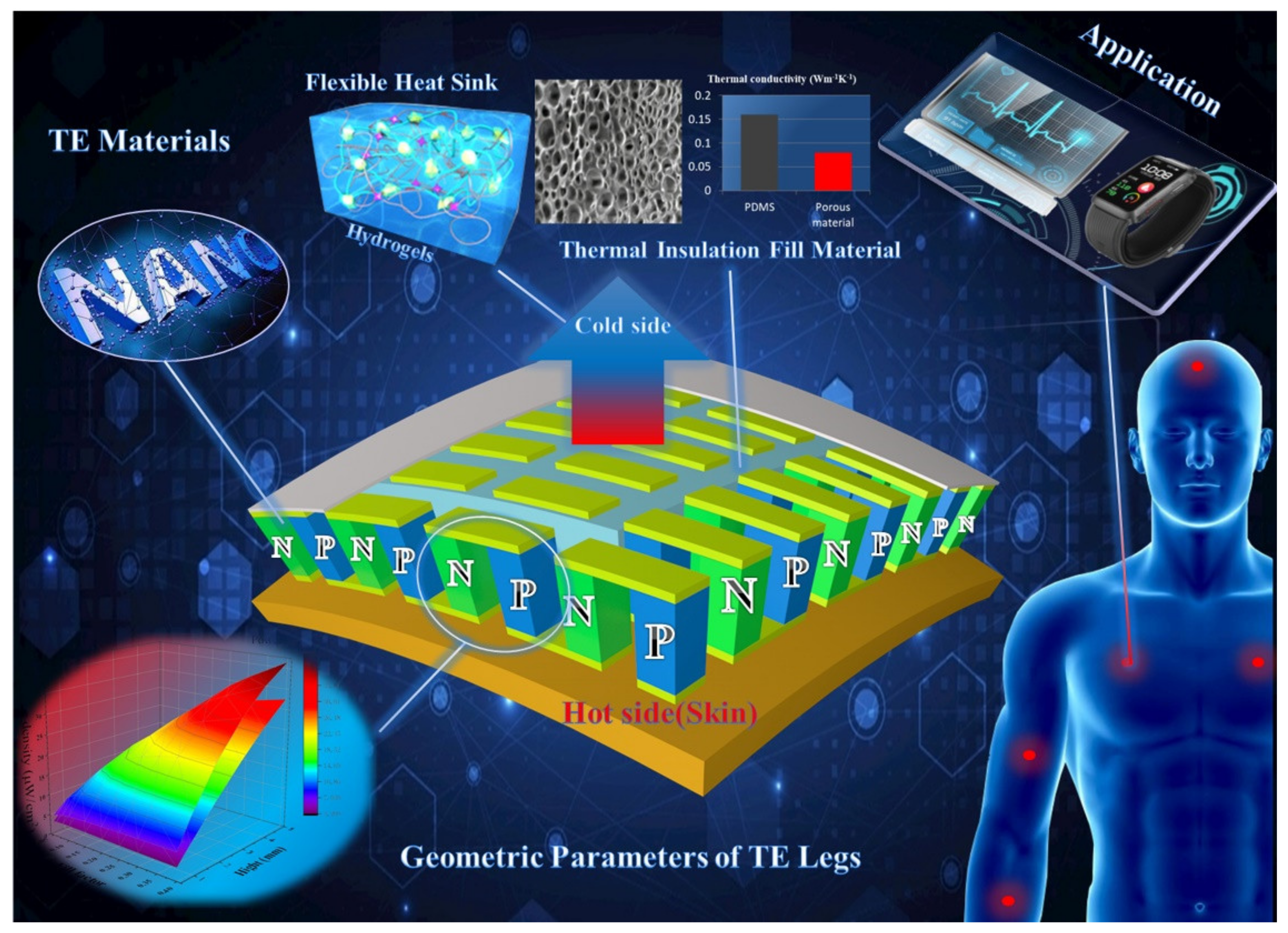
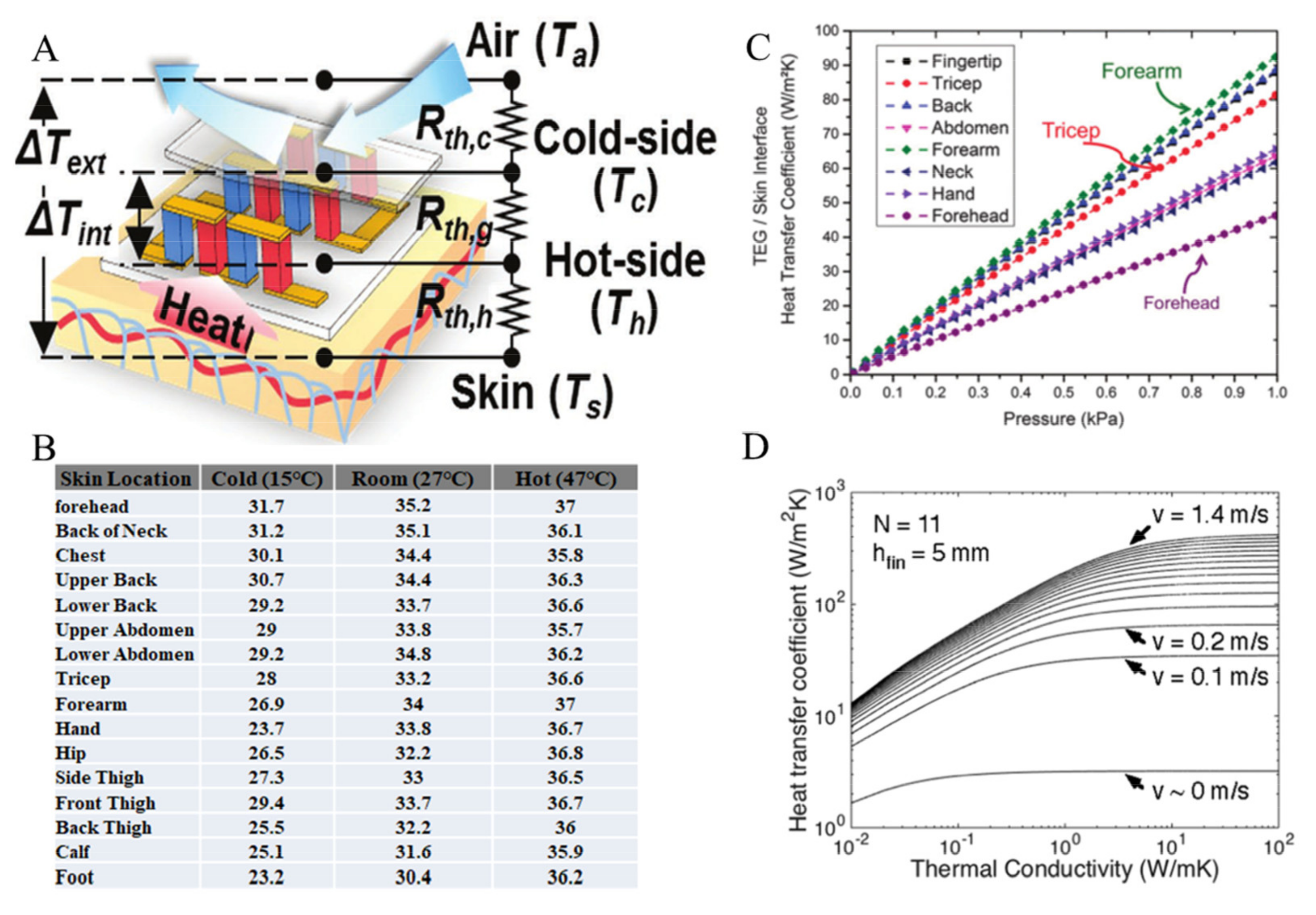
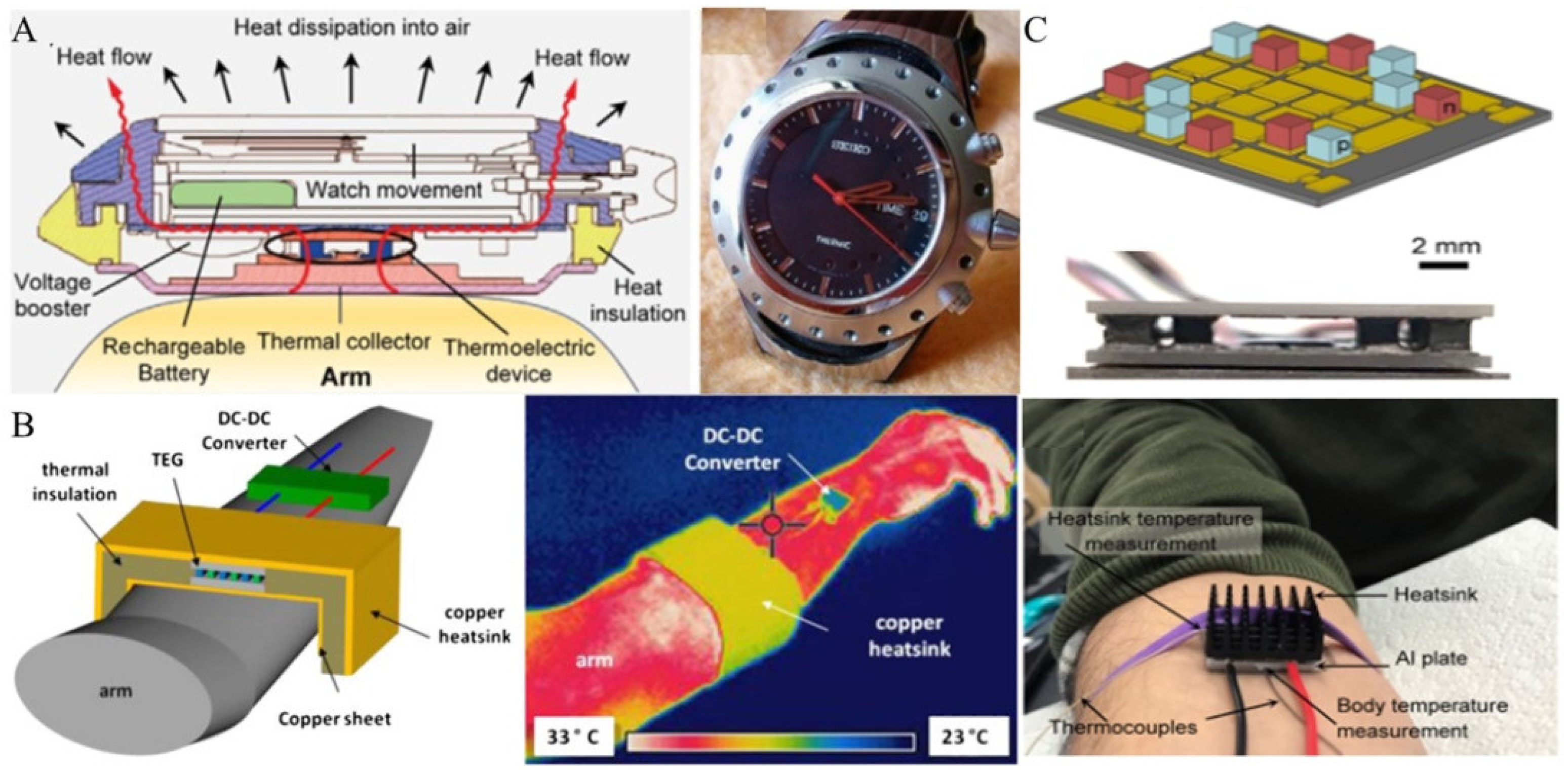
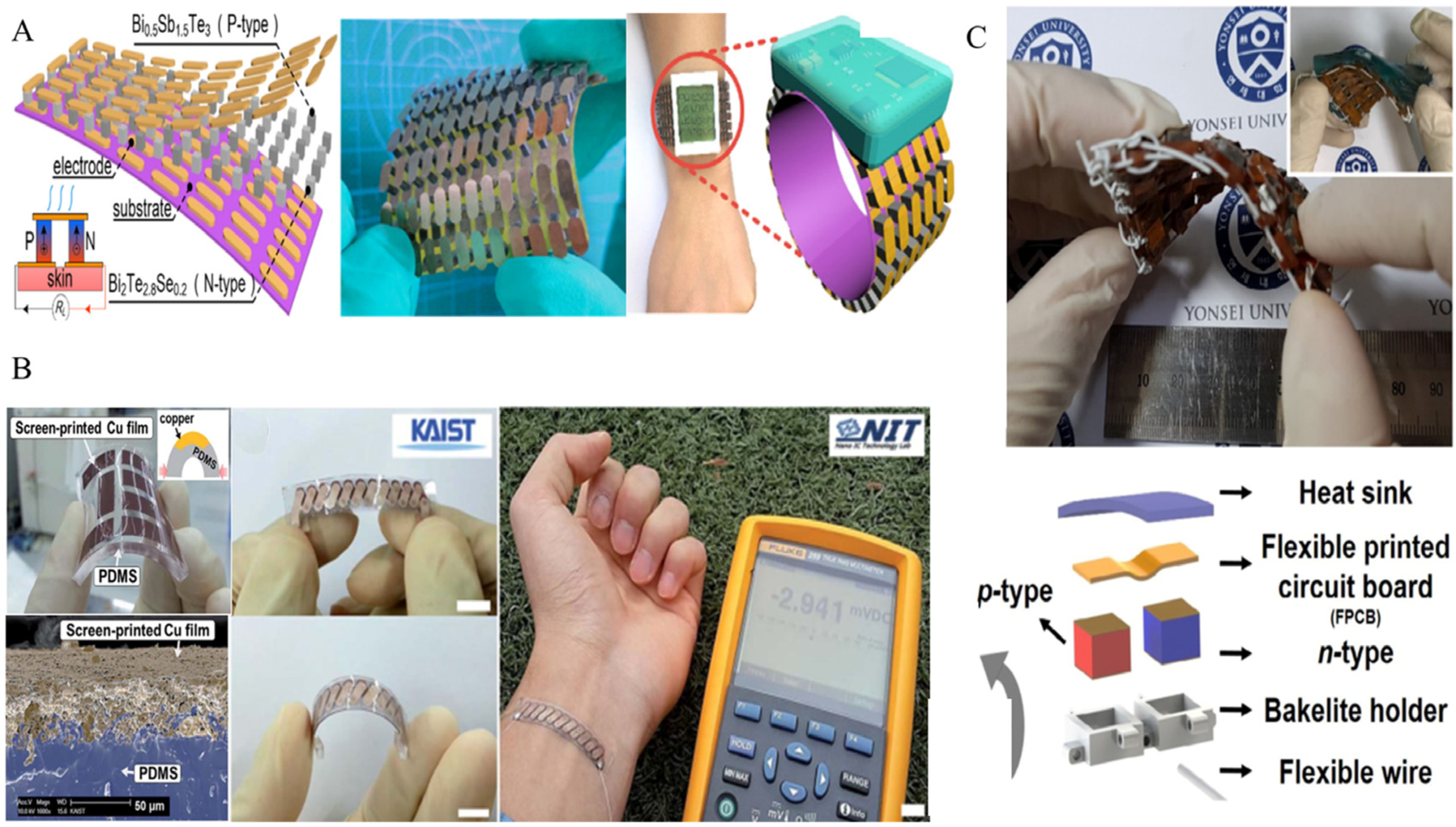
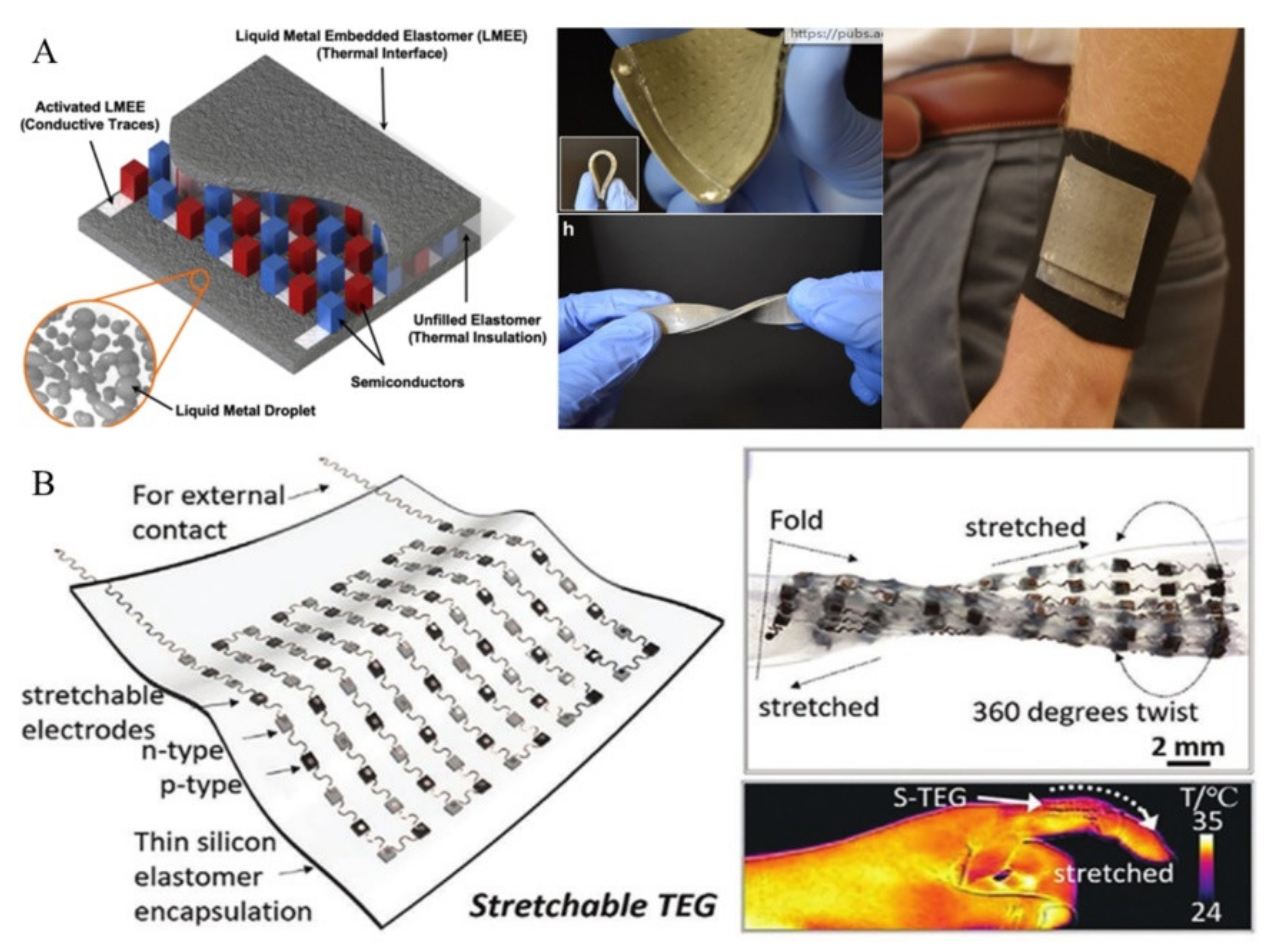
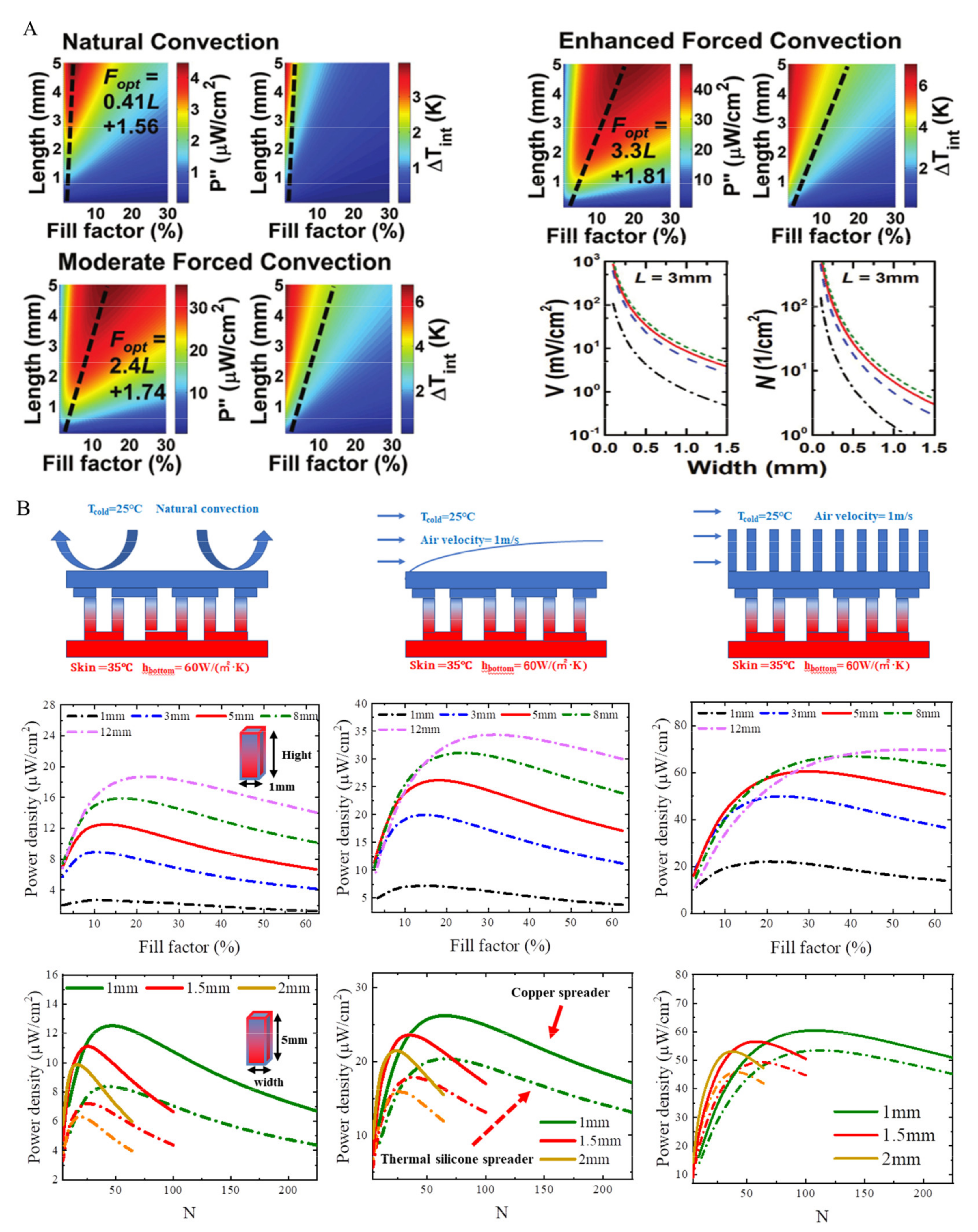
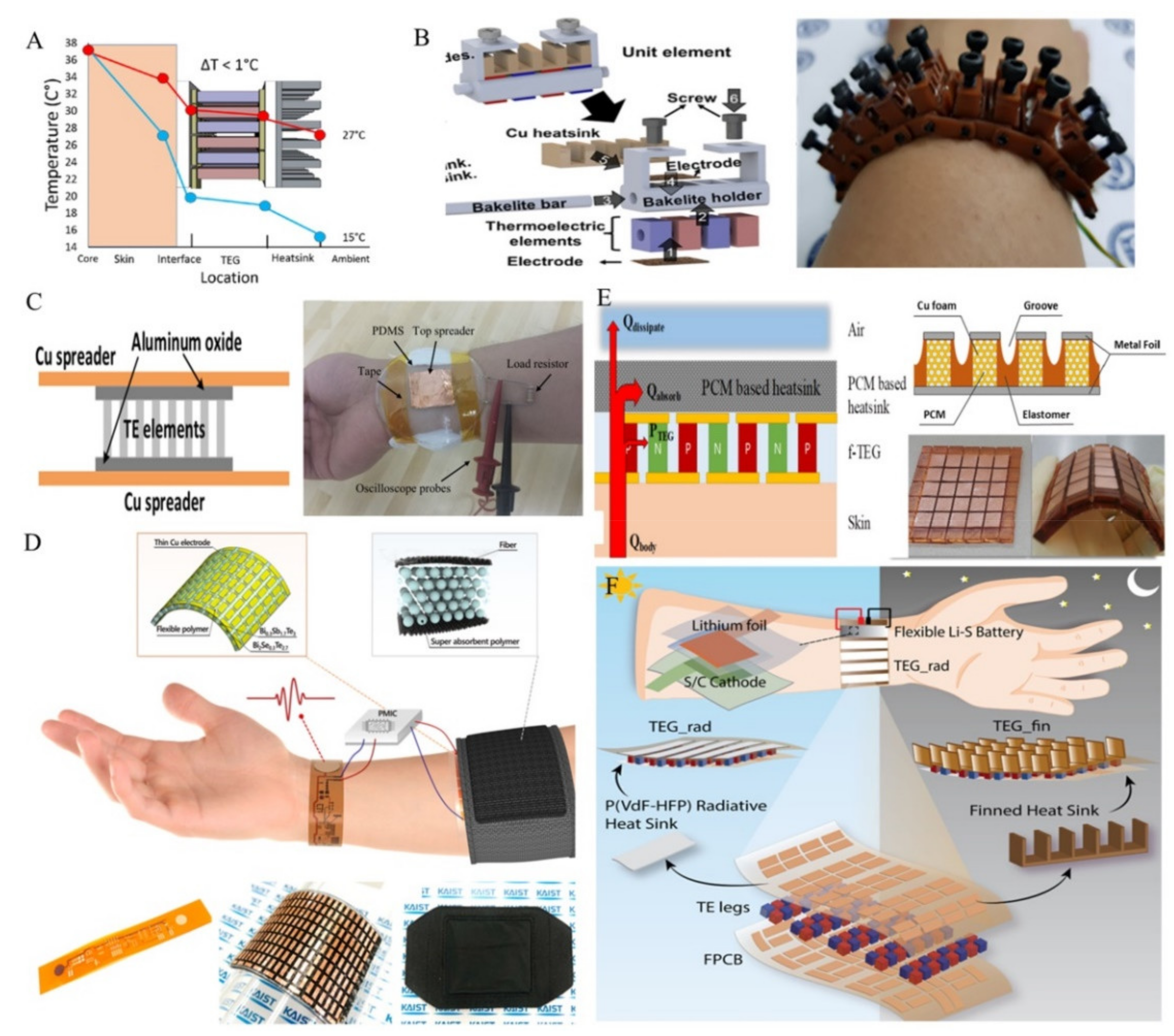
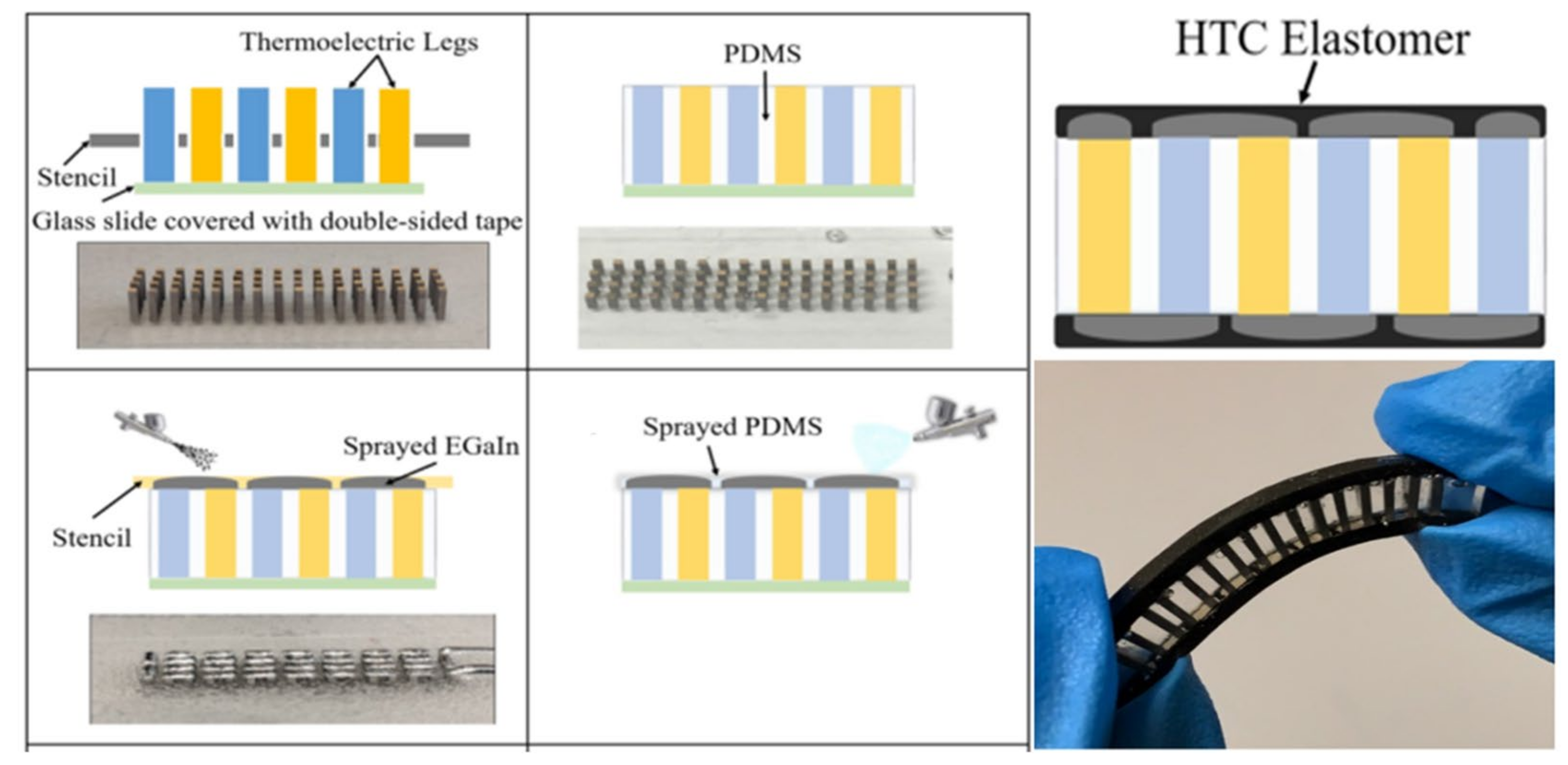
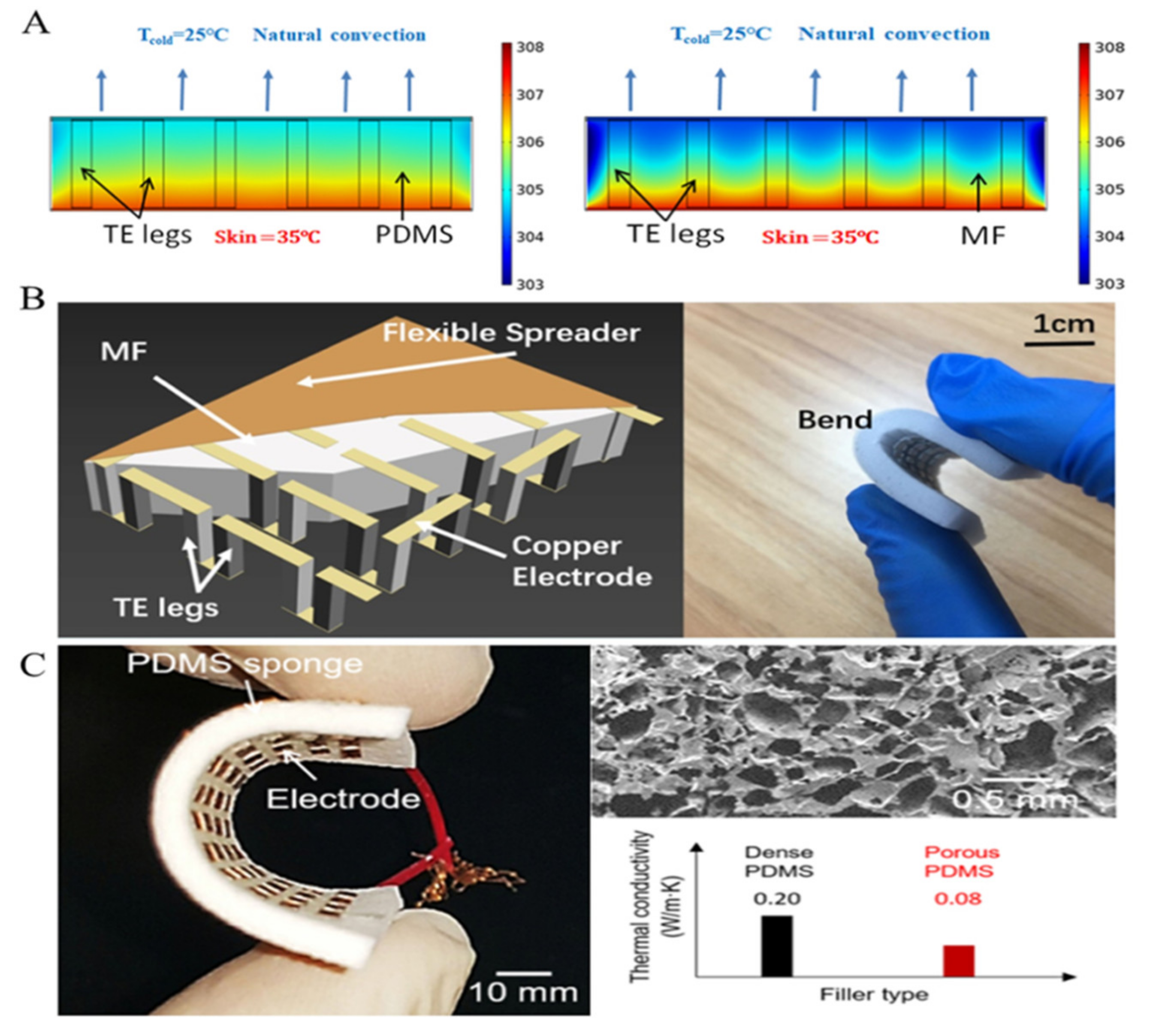

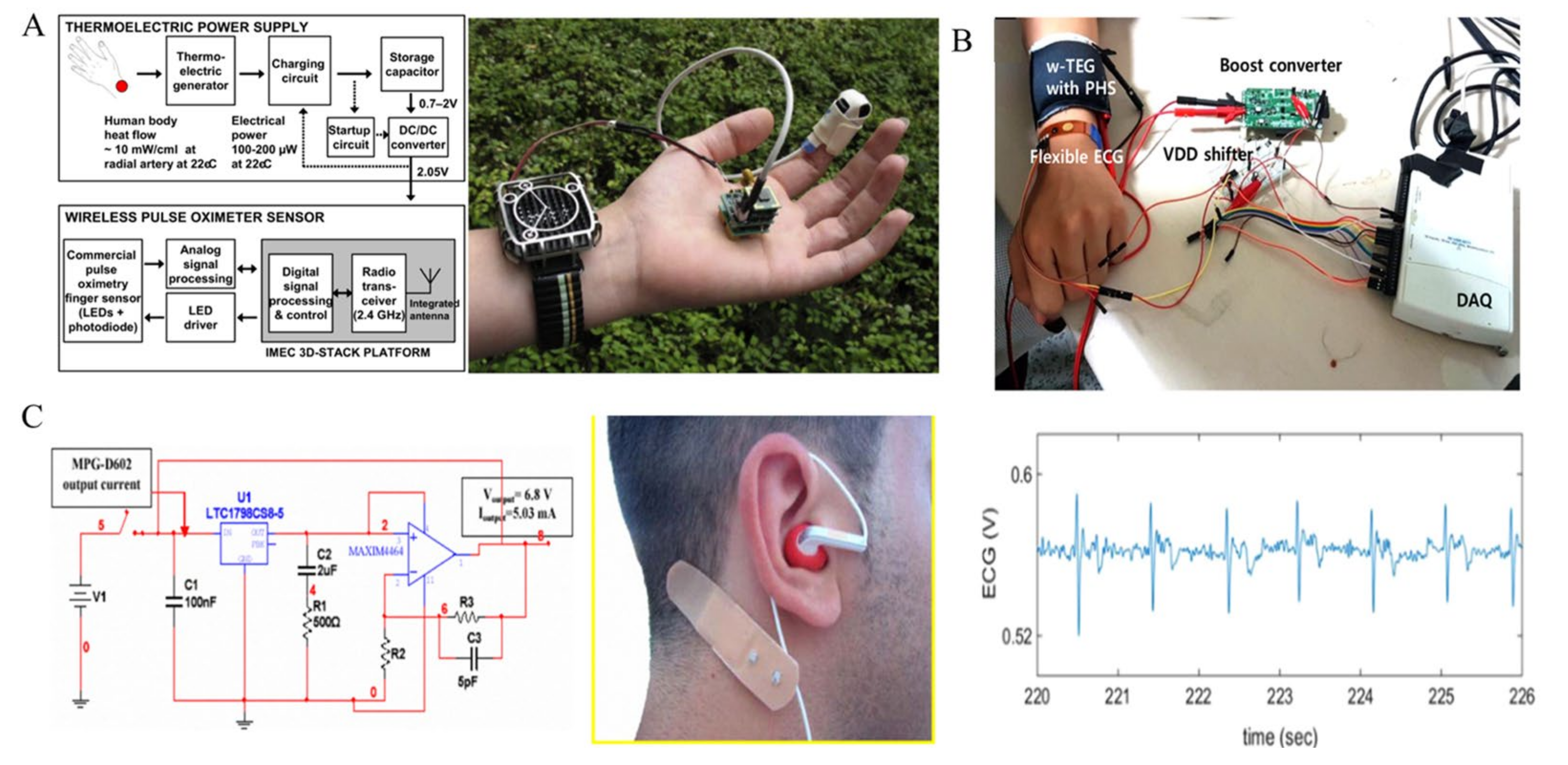

| Types of WTEGs | Materials of TE Legs | ZT or Efficiency | Encapsulation | Electrode | Ambient Temperature | Heat Sink | Power Density (μW/cm2) | Ref. |
|---|---|---|---|---|---|---|---|---|
| r-WTEG | Bismuth Telluride | 0.8 | PDMS/Alumina | Copper | 18.3 °C | Heat spreader | 6 | [54] |
| r-WTEG | Commercial Bi2Te3 | / | Alumina | Copper | 22 °C | Plate fin heat sink | 20 | [46] |
| r-WTEG | Commercial Bi2Te3 | / | Ceramic | Copper | 23 °C | Plate fin heat sink | 28.5 | [47] |
| r-WTEG | Bi2Te3 | 0.14% | AlN | Copper | 17 °C | Plate fin heat sink | 35 | [48] |
| r-WTEG | Bi2Te3 | / | AlN | Copper | 25 °C | Heat spreader | 44 | [55] |
| ns-FTEG | Commercial Bi2Te3 | / | PDMS | FPC | 13 °C | No | 0.084 | [56] |
| ns-FTEG | Bi2Te3(Glass fabric) | / | PDMS | Copper | 15 °C | No | 0.75 | [50] |
| ns-FTEG | Commercial Bi2Te3 | / | No | FPC | 19 °C | No | 0.4 | [57] |
| ns-FTEG | Commercial Bi2Te3 | / | PDMS | FPC | 25 °C | No | 0.526 | [58] |
| ns-FTEG | Commercial Bi2Te3 | / | Polymer | Copper | 25 °C | No | 2.28 | [59] |
| ns-FTEG | Commercial Bi2Te3 | 0.35 | PDMS | LM | 5 °C | No | 2.5 | [60] |
| ns-FTEG | Commercial Bi2Te3 | 0.85 | No | FPC | 13 °C | No | 3.5 | [49] |
| ns-FTEG | Commercial Bi2Te3 | 0.71 | PDMS | Copper | 24 °C | No | 4.5 | [61] |
| ns-FTEG | Commercial Bi2Te3 | / | PDMS | LM | 24 °C | No | 5.2 | [62] |
| ns-FTEG | Commercial Bi2Te3 | / | Aerogel/PDMS | LM | 24 °C | No | 5.4 | [63] |
| ns-FTEG | Commercial Bi2Te3 | / | MF | Copper | 24 °C | Heat spreader | 7 | [64] |
| ns-FTEG | Bi2Te3 | / | Bakelite | Copper | 20 °C | Plate fin heat sink | 1.6 | [65] |
| ns-FTEG | Bi2Te3 | / | Bakelite | Copper | 24 °C | Flexible heat sink | 4.78 | [51] |
| ns-FTEG | Bi2Te3 | / | Bakelite | Copper | 24 °C | Flexible heat sink | 5.6 | [66] |
| ns-FTEG | Bi2Te3 | / | Bakelite | Copper | 24 °C | Plate fin heat sink | 5.6 | [67] |
| ns-FTEG | Bi2Te3 | 0.75 | Fabric | Copper | 24 °C | Air velocity: 0.2m/s | 6.3 | [68] |
| ns-FTEG | Bi2Te3 | / | No | Copper | 24 °C | Plate fin heat sink | 8 | [69] |
| ns-FTEG | Bi2Te3 | / | PDMS | LM&Copper | 24 °C | Hydrogels | 8.3 | [65] |
| ns-FTEG | Commercial Bi2Te3 | 0.75 | Porous PDMS | Copper | 24 °C | SAP heat sink | 9.7 | [70] |
| ns-FTEG | Commercial Bi2Te3 | 0.68 | Polymer | Copper | 24 °C | SAP heat sink | 13 | [71] |
| ns-FTEG | Bi2Te3 | / | No | FPC | 24 °C | Radiant cooling | 12.5 | [72] |
| ns-FTEG | Mg3Bi2/Bi2Te3 | / | Porous PU | Copper | 16 °C | Air velocity: 1.1m/s | 20.6 | [73] |
| ns-FTEG | Commercial Bi2Te3 | 0.64 | Polymer | Copper | 13 °C | PCM heat sink | 20 | [74] |
| s-FTEG | Bi2Te3 (PEDOT:PSS) | / | PDMS | Copper | ΔT=33K | No | 0.87 | [53] |
| s-FTEG | Bi2Te3 | / | Elastic fabric | Polyester Fiber | ΔT=33K | No | 1 | [75] |
| s-FTEG | Commercial Bi2Te33 | / | PDMS | LM | ΔT=10K | No | 4 | [52] |
| s-FTEG | Bi2Te3 | / | PDMS/Ag-Ni | AgNW | 10 °C | No | 6.97 | [76] |
Publisher’s Note: MDPI stays neutral with regard to jurisdictional claims in published maps and institutional affiliations. |
© 2022 by the authors. Licensee MDPI, Basel, Switzerland. This article is an open access article distributed under the terms and conditions of the Creative Commons Attribution (CC BY) license (https://creativecommons.org/licenses/by/4.0/).
Share and Cite
Zhu, S.; Fan, Z.; Feng, B.; Shi, R.; Jiang, Z.; Peng, Y.; Gao, J.; Miao, L.; Koumoto, K. Review on Wearable Thermoelectric Generators: From Devices to Applications. Energies 2022, 15, 3375. https://doi.org/10.3390/en15093375
Zhu S, Fan Z, Feng B, Shi R, Jiang Z, Peng Y, Gao J, Miao L, Koumoto K. Review on Wearable Thermoelectric Generators: From Devices to Applications. Energies. 2022; 15(9):3375. https://doi.org/10.3390/en15093375
Chicago/Turabian StyleZhu, Sijing, Zheng Fan, Baoquan Feng, Runze Shi, Zexin Jiang, Ying Peng, Jie Gao, Lei Miao, and Kunihito Koumoto. 2022. "Review on Wearable Thermoelectric Generators: From Devices to Applications" Energies 15, no. 9: 3375. https://doi.org/10.3390/en15093375
APA StyleZhu, S., Fan, Z., Feng, B., Shi, R., Jiang, Z., Peng, Y., Gao, J., Miao, L., & Koumoto, K. (2022). Review on Wearable Thermoelectric Generators: From Devices to Applications. Energies, 15(9), 3375. https://doi.org/10.3390/en15093375





